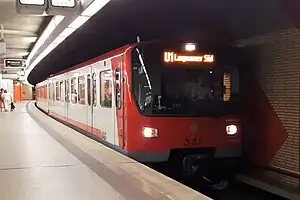VAG Class DT2
The VAG Class DT2 is an electric multiple unit (EMU) train type operated by the Verkehrs-Aktiengesellschaft Nürnberg on the Nuremberg U-Bahn system. It is a derivative of the MVG Class B, in service on the Munich U-Bahn since 1981.[1][2]
| VAG Class DT2 | |
|---|---|
 A DT2 train at Plärrer station in August 2016 | |
| Manufacturer | MAN |
| Constructed | 1993–1994 |
| Number built | 24 vehicles (12 sets) |
| Number in service | 24 vehicles (12 sets) |
| Formation | 2 cars per trainset |
| Fleet numbers | 529/530–551/552 |
| Capacity | 290 (82 seated) |
| Operator(s) | VAG |
| Specifications | |
| Car body construction | Aluminium |
| Train length | 37,500 mm (123 ft 0 in) |
| Width | 2,900 mm (9 ft 6 in) |
| Doors | 3 pairs per side |
| Maximum speed | 80 km/h (50 mph) |
| Weight | 55 t |
| Traction system | Three-phase |
| Power output | 876 kW |
| Electric system(s) | 750 V DC, 3rd rail |
| Current collector(s) | contact shoe pantograph (maintenance only) |
| Braking system(s) | Resistor brake, pneumatic brake, spring accumulator brake |
| Track gauge | 1,435 mm (4 ft 8+1⁄2 in) |
Formation
Every DT2 train consists of two permanently-coupled cars, forming a twin-unit.[1]
| Numbering | xxx | xxx+1 |
|---|---|---|
| Capacity (total/seated) | 145/41 | 145/41 |
| Weight (t) | 55 | |
Interior
Seating accommodation consists of transverse seating bays with ergonomically shaped seats. The interior features less seating spaces than the interior of the VAG Class DT1, in order to provide more space for luggage and standing passengers.[1]
 Interior view
Interior view
Technical specifications
The design is derived from the MVG Class B. The car bodies are made out of aluminium, and the trains are powered by three-phase motors.[1] Unlike its predecessor DT1 and the related Class B, the three-phase motors of the DT2 are arranged transverse to the direction of travel.[1] Besides the power supply by contact shoes, every unit is also equipped with a pantograph, as parts of the maintenance facilities are electrified with overhead lines.[1]
History
As a further order of DT1 trains was deemed unpractical due to the age of the technical design, a newly developed train type was ordered.[3] Twelve sets were built by MAN between 1993 and 1994.[1]
The order of 21 VAG Class G1 trains from Siemens also includes an option for six additional sets, which would replace the DT2 trains.[4][5]
References
- Pabst, Martin (2006). S-Bahn- und U-Bahn-Fahrzeuge in Deutschland [S-Bahn and U-Bahn vehicles in Germany] (in German) (2nd ed.). GeraMond. pp. 74, 82, 83. ISBN 3-7654-7366-9.
- Pischek, Wolfgang; Junghardt, Holger (2012). Die Münchner U-Bahn - Geschichte · Streckennetz · Fahrzeuge [The Munich U-Bahn - History · Network · Rolling stock] (in German) (3rd ed.). GeraMond. pp. 54, 58. ISBN 978-3-86245-148-7.
- Reinhardt, Winfried (2014). Geschichte des Öffentlichen Personenverkehrs von den Anfängen bis 2014: Mobilität in Deutschland mit Eisenbahn, U-Bahn, Straßenbahn und Bus [History of public transport from the beginning to 2014: Mobility in Germany with railway, subway, tramway and bus] (in German). Springer-Verlag. pp. 792, 799. ISBN 978-3-658-06628-4.
- "Nürnberg expects to order Line U1 metro trains". metro-report.com. Metro Report International. November 18, 2015. Archived from the original on May 13, 2019. Retrieved November 5, 2018.
- "Neue U-Bahn-Züge für Nürnberg" [New U-Bahn trains for Nuremberg]. busundbahn.de (in German). DVV Media Group GmbH. December 17, 2015. Archived from the original on November 6, 2018. Retrieved November 5, 2018.
External links
- VAG fleet information (in German)
